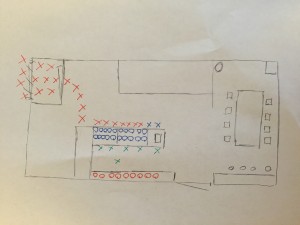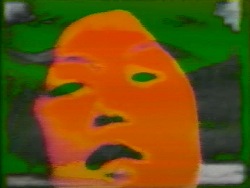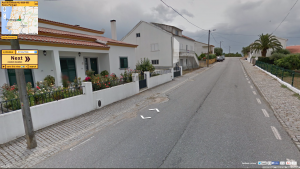Posted: September 14, 2015 Filed under: Anna Brown Massey, Reading Responses Leave a comment »
Some notes
RSVP Cycles – Lawrence Halprin
Scores
- as symbolizations of process e.g. musical, grocery list, calendar, this book
- as method of making process visible
- can communicate processes over space-time
- Hope for socres as way of designing large-scale environments
- Must allow for feedback
- as potential communication device
Environment + dance-theater
- non-static
- process-oriented (not result-oriented)
- values present, but not demonstrable
Resources
Scores
Valueaction
Performance
Order can be any. e.g PRSV
Cycle works at two levels: self, group
– meant to be free–making processes visible
Danger: becoming goal-oriented… scores are non-utopian; they’re idealistic, hope-oriented
Score: system of symbols to convey/guide/control interactions between elements: space, time, rhythm, and their sequences, people and activities, and the combinations that result
An Arts Sciences, Engineering Educational Research Initiative for Experiential Media by Rikakis, Spanias, Sundaram, He (2006)
Summary: training approach f/ integrating computation & media in physical human experience
- driven by research problems
- based on interdisciplinary network
- research and application
- transdisciplinary training
Experiential Media: systems that integrate computation and digital media in physical media experience
Three trends in computation:
- novel embedded interfaces e.g. gesture, movement, voice, sketches, etc
- human e.g. computing communication at level of meaning (rather than level of information)
- participational knowledge creation and content e.g. generation frameworks
Research model 5 areas
- Sensing: human word & physical activity
- Perception and modeling
- Feedback
- Experiential construction
- Learning and knowledge
Expertise needed:
- sensing: engineers
- media communication & experiential construction: artists
- perception, cognition, learning: psychology & education experts
Arizona State University has Arts, Media, Engineering (AME) program
Application of this training-research: health, education, social communication, everyday living, culture, arts
Need new folks trained in this
The Work of Art in the Age of Digital Reproduction by Douglas Davis (1991-5)
No longer clear conceptual distinction between original and reproduction – both states are “fictions”
Not “virtual” — actually, virtual is “RR”: Realer Reality
The World’s First Collaborative Sentence ….
Digital reproduction is without degradation: always same/perfect
Empower imagination, not reason –> new tools e.g. printed word invented led hundreds of years later to Ulysses
Reader becomes author on internet –> information is decentralized
We can walk, think, feel virtual world same as human-made world
Deconstruction itself has its own value
When live performers leave the stage and there’s a “live feed” of them backstage, we are unsure whether it’s taped for live e.g. Blue Man Group
Status of first person is still valued
“poststructuralism” “postmodernism” “post-avant-garde” “appropriation”…
* aura resides “not in the thing itself but in the originality of the moment we see, hear, read, repeat, and revise” (386)
Davis, ASU and Halprin Thoughts
Posted: September 13, 2015 Filed under: Alexandra Stilianos, Reading Responses 2 Comments »ART IN THE AGE OF DIGITAL REPRODUCTION- DAVIS
First of all, Davis, do not cast against an age when you claim original art is vanish(ed)ing and then refuse to distinguish ‘The Queen of Touch” who’s identity you claim you “don’t need.” Interesting choice to lead with a dash of hypocrisy.
I found his train of thought around transferring his own work from analog to digital as a revisionist tool interesting. The ‘post-original original.’ I think the ability to reflect and change is not so much indicative of the technology but the time he lived in where there was a major shift of technology. Nothing before was stopping an edit but the transference caused him to reflect.
2 out of 4 stars
ASU READING:RIKAKIS, SPANIAS, SUNDARAM, HE
This article was a great read for me and aptly timed as I am struggling to finding where to engage at the forefront of my Graduate studies. The organizational axes was a great way to visualize where I can cross train in my own strengths and where and how to outsource.
The article was helpful (for me) to engage with a more clear language of what I am looking to attain by studying experiential (and all medias) outside of my discipline or current skill set. Especially the three key trends:
- Novel embedded interfaces (interaction through meaningful multimodal physical activity)
- Human computing communication at the level of meaning
- Participational knowledge creation and content generation frameworks.
3 out of 4 stars
THE RSVP CYCLES- HALPRIN
“… free the creative process by making it visible.”
This could be effective if one feels creatively blocked but opposite perhaps by defining and restraining the possibilities/order.
“Science implies codification of knowledge and drive toward perfectibility…”
No? Science is hypothesis, experiment, posing questions and attempting to try and find answers to them?
This article was incongruent and kind of repetitive for me, 1 out of 4 stars.
The Most Iconic Level in video games. Ever.
Posted: September 12, 2015 Filed under: Uncategorized Leave a comment »A look into the design intentions and lessons learned behind the first level of Super Mario Bros.’s creators:
Article on Technology Worship vs. Holistic Consideration of Behavior and Experience
Posted: September 11, 2015 Filed under: Extras Leave a comment »http://nautil.us/issue/28/2050/why-futurism-has-a-cultural-blindspot

Check out his performance interfaces.
Posted: September 11, 2015 Filed under: Extras Leave a comment »https://youtu.be/-izS9AG2C3Q?t=1m48s
Starts midway through for a cute story about sausage.
Start at the beginning for more context.
Length:4:29
Dialogue with Machines- Krieg, Response
Posted: September 9, 2015 Filed under: Alexandra Stilianos, Reading Responses Leave a comment »Cognitive systems do not record data but generate it as an emergent result of their operations.
So, in a perfect world (according to Krieg), a computer can become a cultural probe?
I like the idea that ‘user friendly’ is not a suggestion of more advanced systems but a gimmick. It opens my view finder a bit to what is possible in my own set of skills/languages to create an EMS. If these ideas don’t ‘change the underlying architecture’ what happens to a system when we approach it from a design aesthetic side then see what technologies and systems are available to actuate it. This is kind of that antithesis of the article because I no longer need a reasoning dialogue with the machine, but nonetheless it was a train of thought.
Plus, don’t all robots (fictional of course, well maybe not… WHOA) die just as they were learning to love?
Jenis High Street Short North
Posted: September 9, 2015 Filed under: Josh Poston, Pressure Project I Leave a comment »Jeni’s
Friday September 4th
10-11pm
I have yet to walk into a Jenis Ice Cream that has a well-designed traffic or work flow model. Customers enter into the store through the main entrance. They approach a counter that has all of the flavors of ice cream twice linearly enabling more employee workstation. However this is limited by the presence of a single workstation setup on the back counter where all of the necessary condiments and garnishes are. This leads to a turn around and wait until the path is unoccupied by the other employees that are all heading to the same point.
If a customer is unfamiliar with the setup they will not understand that the flavors are repeated at the two ice cream coolers and stand unknowingly at the first one reluctant to miss a flavor. This is something I have witnessed several times due to the lack of signage indicating the proper protocols as a customer. Protocol involves in this instance always moving forward. From waiting to order to, and having placed your order until checkout.
I would propose that the system would benefit from a call system on the back wall that would bring the necessary item to the ice cream preparer rather then them having to fight the crowd every time. The necessary items are keyed in and then delivered right behind the appropriate individual. Additionally Jeni’s should acquire spaces that allow for an increased traffic flow. My drawing implies that there is much more open space than there actually is within the store. There could also be interactive signage or a system that can tell people when to move forward, welcome them, inform them of the general flow model of the space, or perhaps assist them in making decisions, it could tell them some good flavor combinations based on different desires.
Rimini Protokoll
Posted: September 9, 2015 Filed under: Extras Leave a comment »
Please take a good look at the various projects, performances, and installations that this group has created in the recent past.
http://www.rimini-protokoll.de/website/en/index.php
Especially
Home Visit and Situation Rooms
Above the Desert
Posted: September 9, 2015 Filed under: Extras 1 Comment »A random place on the great map.


